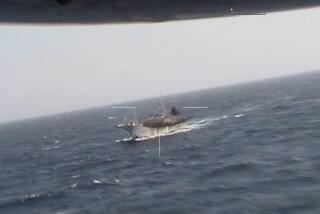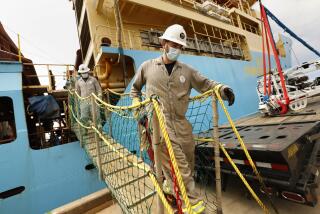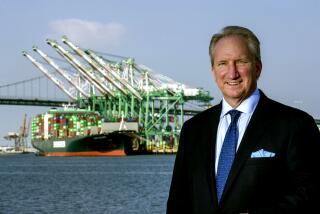Q&A: An ocean of threats must be tackled to protect the world’s ‘blue economy,’ U.S. undersecretary says

- Share via
They are the lifeblood of our planet, responsible for more than half of the oxygen we breathe. They regulate the climate, provide a major source of protein for 3 billion people, and millions of livelihoods — including 1 of every 6 jobs in the United States — are connected to the marine environment.
But the world’s oceans are under extreme duress, and humans are primarily to blame.
“I think we sometimes take it for granted, especially if you are located someplace where you don’t see the ocean every day,” Catherine A. Novelli, U.S. undersecretary for economic growth, energy and the environment, said during a recent interview with The Times.
That’s why a key aim of the Our Ocean Conference to be hosted by Secretary of State John F. Kerry in Washington this week is to “elevate the ocean in people’s consciousness,” Novelli said.
Participants in the first two Our Ocean conferences, launched in 2014, pledged nearly $4 billion to conservation activities globally and committed to set aside special protection areas for nearly 2.3 million square miles of the world’s seas.
“We in the U.S. have about a third of our ocean protected,” Novelli said. “The global amount protected is only about 3%. So we have a ways to go.”
She explained some of the reasons why in her discussion with The Times, which has been edited for length and clarity.
What are some of the main threats to the ocean?
The ocean has absorbed 30% of all the carbon that we have put out into the atmosphere since the Industrial Revolution. The carbon in the atmosphere is a huge threat to the ocean because the ocean is absorbing all of this carbon and that means that the acidity level of the ocean is increasing. That means that corals, for example, end up being bleached out, and, of course, [they] are a part of the food chain, so it’s very important that they remain healthy. The shells on shellfish become really soft and they can’t survive.
Illegal fishing [is another threat]... But here’s the good news: If you really start to manage your fish stocks, they can come back. In the U.S., we were in a terrible situation. The National Oceanic and Atmospheric Administration stepped in with really robust management programs and our fisheries have rebounded.
The same thing happened in the EU as well. But globally, we do have a little issue.
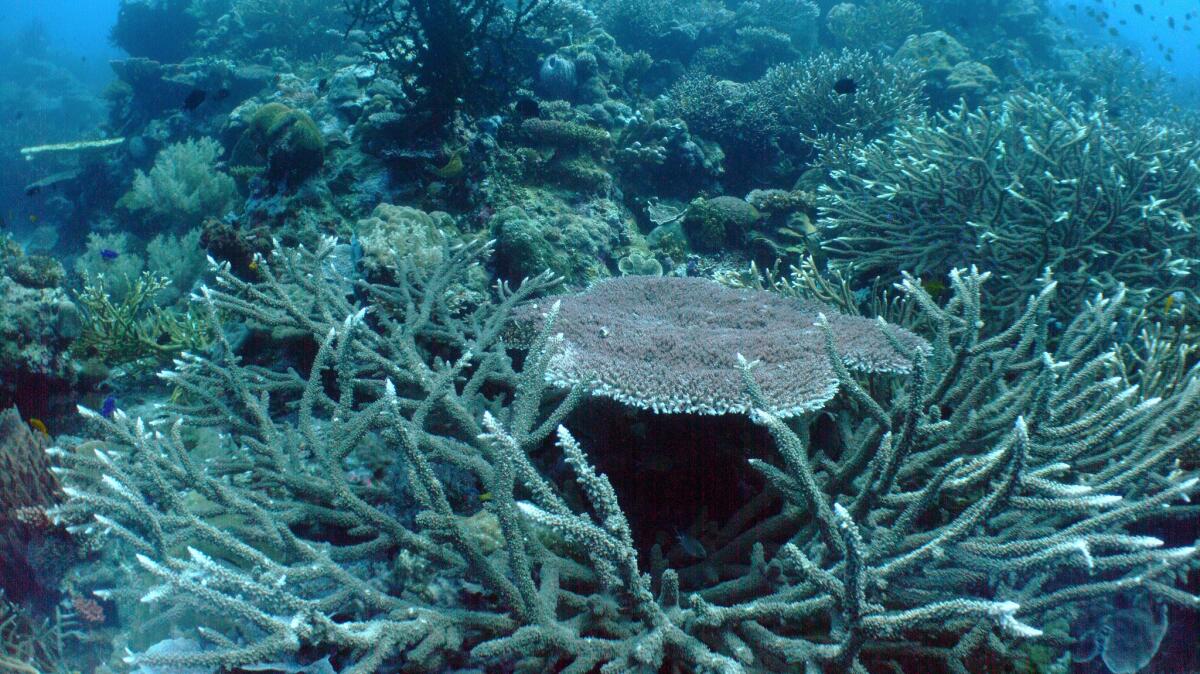
How do you combat the threat of rising acidity?
What we’re doing right now is trying to start monitoring where the higher levels of acid are, how does that move around, and then look at mitigation strategy and what can be done.
For example, there are shellfish farmers who are monitoring themselves [and] what’s happening with the acidity, and if they see that there’s more acid than normal coming their way they can put up something that keeps the ocean from invading [their farms], and wait until it moves on.
What about tackling illegal and unregulated fishing?
So what are the ways to deal with that? One is to create marine protected areas. They’re kind of like national parks of the ocean, where there isn’t fishing so the fish are allowed to rejuvenate in these areas.
[Then there’s] ]the Port State Measures Agreement. It’s a treaty. It started off with the idea that if you’re going to illegally fish, you’ve got to bring the fish to land at some point to sell it. So the idea was to use the ports as a choke point, to say we who have signed on to this treaty aren’t going to allow boats with illegally caught fish to dock at our ports and unload this fish.
Two years ago when we started our oceans conference, only 10 countries had signed on. You need 25 for [the treaty] to enter into force. We’re over 60 countries now, so it’s entered into force, and we’re looking for many, many more.
We have [also] launched Operation Safe Ocean Network. There’s a lot of technology out there that can be used to monitor either from satellite — to see if there are boats where they’re not supposed to be — or in the ocean where you can use sonar to detect fish and distinguish them from other things, such as submarines. The theory being that if you combine [monitoring] from space and below the sea, you can actually be much more precise about where illegal fishing is going on and be able to notify countries if this is in their territorial waters … and then work with them to interdict those who are illegally fishing and then, of course, prosecute those people.
How challenging is it to tackle these illicit activities?
It’s very difficult. The ocean is huge. That’s why we have this initiative because the idea is [to] use technology to pinpoint the likely places where something might be going on. We’re narrowing down where we’re going to be looking for these illegal fishing boats.
We expect to have close to two dozen pilot projects looking at how we can combine this technology in different parts of the world, working with partner countries, and then we’ll keep expanding it.
The U.S. is doing [more] to deal with illegal fishing. We have put out a regulation that will require fishers to be able to trace their fish from the place they caught it — from bait — to where it crosses to land. Our own domestic fishers already have to do this. We’re now expanding those rules to everybody.
Ninety percent of the seafood we eat in the U.S. is imported. So we’re hoping this is going to have a big impact.
What do you mean by the term “blue economy”?
The idea is [that] the ocean has many, many resources, and they are resources that should be able to be developed for the benefit of the people who are using them. There is a way of developing these resources that also conserves them.
If you want to have a sustainable economy based on the ocean, you can’t sustain that unless you’re conserving it at the same time. Otherwise you’ll use it up. And similarly, you want to have conservation. But you can’t really sustain that unless there’s an ability to economically sustain that. So it’s that meshing of environment and economics that is really the blue economy.
How devastating is marine pollution and what’s being done to combat it?
There are two primary sources of marine pollution. Plastic and runoff from fertilizer.
On the plastic side, the amount of plastic going into the ocean right now is enough to line every coast that touches the ocean five deep of garbage bags full of plastic. If we continue at the pace that we’re going, there will be 1 ton of plastic for every 3 tons of fish in the ocean. Not only is it ugly, it gets tangled up in plants. It breaks down into smaller pieces. Fish eat that and then we eat fish. It’s just horrible.
The problem is way worse in Asia than any other place in the world. That’s because you have a rising middle class who’s buying disposable things, stuff that’s packaged in plastic. They have much more ability to purchase, and their waste-management systems are not as developed to keep up with that.
So there are several solutions being looked at there. One is, how do you give this plastic value so that people just don’t throw it away?
We have two pilot projects going, one in the Philippines, another is in Indonesia. [The first] is to take this plastic and turn it into energy. It has to be energy that doesn’t pollute, otherwise you defeat the purpose. It’s called waste-to-worth. The second [program involves] the design of all this packaging. How do you use less? How do you design things that are truly completely biodegradable?
In terms of fertilizer, what happens is this fertilizer runs off the land. It’s excess; it hasn’t been absorbed. It goes into the waterways and, of course, every waterway always ends up in the ocean. Algae eats this fertilizer. The algae sucks oxygen out of the ocean and then you create these dead zones because you need to have oxygen in the water in order for fish to live.
The second largest of these dead zone is in the Gulf of Mexico off the coast of Louisiana, Mississippi. So A, how can we use smarter systems for delivering the fertilizers so you don’t over-fertilize? And B, there are some simple mitigation measures you can do such as simply digging double trenches around your field so the runoff [faces] a little bit of resistance before it gets all the way into the water.
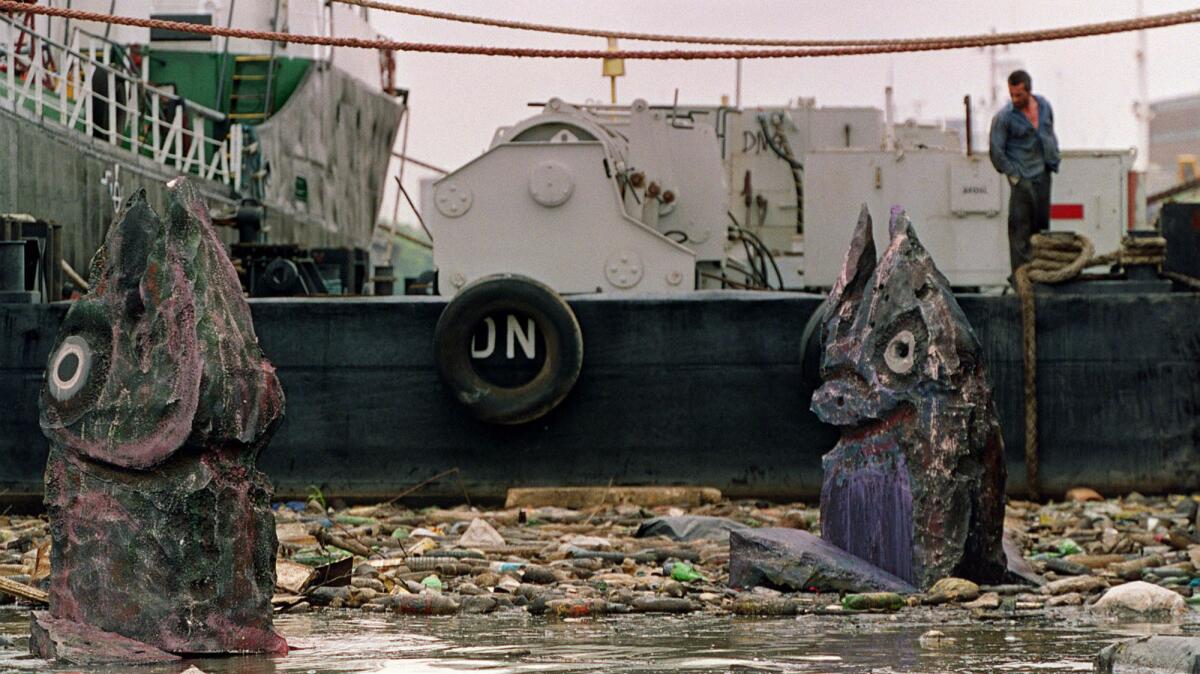
What’s the goal of the Our Ocean conferences and is there a particular theme for this year?
The theme of Our Ocean, and the goal, is to educate the population of the world, not just scientists and experts, but everybody, about the importance of the ocean, about the challenges that the ocean is facing, and about what can be done about it.
The areas it’s going to focus on are marine-protected areas/overfishing, illegal fishing, pollution of the ocean, climate effects on the ocean, and the theme that runs through all of those is the theme of the blue economy. In other words, how do we tackle these things, keeping in mind these twin objectives of economic sustainability and environmental sustainability?
For more on global development news follow me @AMSimmons1 on Twitter
More to Read
Sign up for Essential California
The most important California stories and recommendations in your inbox every morning.
You may occasionally receive promotional content from the Los Angeles Times.
